UPSC 2022 countdown has begun! Get your personal guidance plan now! (Click here)
03 Sept 2021
Soil Characteristics
Knowing a soil’s water, mineral, and organic components and their proportions can help us determine its productivity and what the best use for that soil may be. Several soil properties that can be readily tested or examined are used to describe and differentiate soil types. The most important properties are discussed below:
1. Colour: A soil’s colour is generally related to its physical and chemical characteristics. E.g.
- Soils rich in humus tend to be dark because decomposed organic matter is black or brown. Soils with high humus content are usually very fertile, so dark brown or black soils are often referred to as ‘rich’. [Note – Some dark soils may be dark because of other soil forming factors and may have little or no humus]
- Red or yellow soils typically indicate the presence of iron.
2. Texture: The soil texture refers to the coarseness/fineness of the mineral matter in the soil. It is determined by the proportion of the sand, silt and clay particles:
- Clay: Particle Size – diameters less than 0.002 millimetre
- Silt: Particle Size – diameters between 0.002 millimetres to 0.05 millimetres.
- Sand: Particle Size – diameters between 0.05 and 2 millimetres.
[Rocks larger than 2 millimetres are regarded as pebbles, gravel, or rock fragments and technically are not soil particles.]
Note: Clay being the finest of all plays the most important role in soil chemistry (offers more surface area).
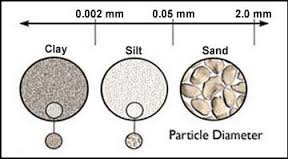
The proportions of each of these soil fractions determine soil texture and its properties.

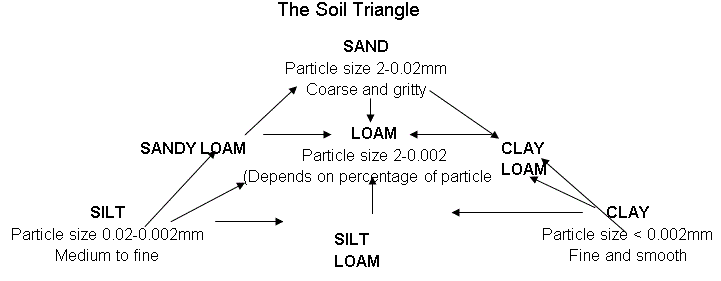
The soil texture directly affects:
- The soil water content
- Water flow
- Retention of nutrients
- Extent of aeration
Loamy Soil: Loamy soil is the one in which none of the three (sand/silt/clay) dominates the other two. In particular, loamy soil has about 40% sand, 40%silt, and 20% clay.
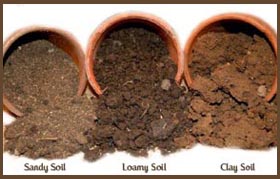
Note: Generally speaking, Good Soils = Clay + Humus. The clay-humus complex is essential for a fertile soil as it provides it with a high water and nutrient holding capacity. Humus acts as a cement binding the soil particles together and thus reducing the risk of erosion.
3. Structure :
While the soil texture describes the size of soil particles, soil structure refers to the arrangement of the soil particles. The way in which sand, silt, clay and humus bond together is called soil structure. Structure can partially modify the effects of soil texture.
Some structural characteristics of soil:
- Permeability – The ease with which liquids/gases can pass through rocks or a layer of soil is called permeability. It depends on the size, shape and packing of particles. It is usually greatest in sandy soils and poor in clayey soils.
- Porosity – The volume of water which can be held within a soil is called its porosity. It is expressed as a ratio of volume of voids (pores) to the total volume of the material.
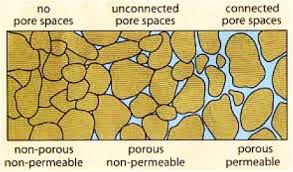
- Note: Most porous rocks are permeable with the exception of clay in which pore spaces are so small that they are often sealed with groundwater held by surface tension. Another exception – granite is non-porous but permeable. It is a crystalline rock and hence non-porous. Its individual crystals absorb little or no water but the rock may have numerous joints/ cracks through which the water can pass rendering it permeable.
- A soil with high organic content also tends to have high porosity.
4. Soil Chemistry – Acidity or Alkalinity:
An important aspect of soil chemistry is acidity, alkalinity (baseness), or neutrality.
Low pH values indicate an acidic soil, and a high pH indicates alkaline conditions. Most complex plants grow only in the soils with levels between pH 4 and pH 10 but optimum pH varies with the plant species.

- In arid and semi-arid regions, soils tend to be alkaline and soils in humid regions tend to be acidic.
- To correct soil alkalinity and to make the soil more productive, the soil can be flushed with irrigation water.
- Strongly acidic soils are also detrimental to plant growth, but soil acidity can generally be corrected by adding lime to the soil.
Now that we are done with the basics, let’s move on to the soils of India!
Soils of India
India has varied relief features, landforms, climatic realms and vegetation types. These have contributed to the development of various types of soils in India.
Various classifications adopted to study the Indian Soils:
1. In ancient times, soils used to be classified into two main groups:
- Urvara (i.e. fertile), and
- Usara (i.e. sterile)
2. In the 16th century A.D., soils were classified on the basis of their inherent characteristics and external features such as texture, colour, the slope of land and moisture content in the soil.
- Based on texture, main soil types were identified as sandy, clayey, silty and loam, etc.
- On the basis of colour, they were red, yellow, black, etc.
3. The National Bureau of Soil Survey and the Land Use Planning an Institute under the control of the Indian Council of Agricultural Research (ICAR) did a lot of studies on Indian soils. In their effort to study soil and to make it comparable at the international level, the ICAR has classified the Indian soils on the basis of their nature and character as per the United States Department of Agriculture (USDA) Soil Taxonomy.

Chief characteristics of these are:
- Entisols – Immature soils that lack the vertical development of horizons. These soils are often associated with recently deposited sediments from wind, water, or ice erosion. Given more time, these soils will develop into another soil type.
- Inceptisols – young soils that are more developed than entisols.
- Vertisols – heavy clay soils that show significant expansion and contraction due to the presence or absence of moisture. These are common in areas that have shale parent material and heavy precipitation.
- Aridisols – soils that develop in very dry environments.
- Ultisols – associated with humid temperate to tropical climates. Warm temperatures and the abundant variability of moisture enhance the weathering process and increase the rate of leaching in these soils.
- Mollisols – soils common to grassland environments
4. On the basis of genesis, colour, composition and location, the soils of India have been classified into:
(i) Alluvial soils
(ii) Black soils
(iii) Red and Yellow soils
(iv) Laterite soils
(v) Arid soils
(vi) Saline soils
(vii) Peaty soils
(viii) Forest soils.
5. Another way of classifying rocks is on the basis of dominant soil-forming factors:
- Zonal Soil – These soils occur in broad geographical areas or zones.
- They are influenced more by the climate and vegetation of the area rather than the rock-type.
- They are mature, as a result of stable conditions over a long period of time.
- For example – red soils, black soils, laterite soils, desert soils etc.
- Azonal Soil – It is that soil which has been developed by the process of deposition by the agents of erosion.
- It means that it has been made by the fine rocky particles transported from the far-off regions.
- These are immature soils and lack well-developed soil profiles. This may be due to the non-availability of sufficient time for them to develop fully or due to the location on very steep slopes which prohibits profile development.
- For Example – alluvial and loess soils.
- Intrazonal Soil – These soils occur within other zonal soils.
- It is a well-developed soil reflecting the influence of some local factor of relief, parent material, or age rather than of climate and vegetation.
- For example, calcerous soil (soils which develop from limestone), peat soil.
Soils and Crops of India
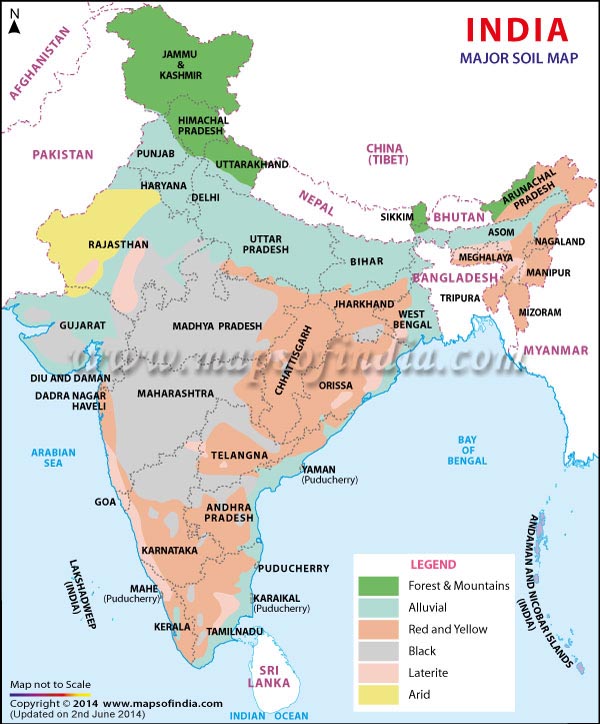
1. Alluvial Soils
- Formation: They are mainly derived from the debris brought down from the Himalayas or the silt left out by the retreating sea. Thus they are azonal soils.
- Areas: Alluvial soils are widespread in the northern plains and the river valleys. Through a narrow corridor in Rajasthan, they extend into the plains of Gujarat. In the Peninsular region, they are found in deltas of the east coast and in the river valleys.
- Soil texture: The alluvial soils vary in nature from sandy loam to clay. These soils are more loamy and clayey in the lower and middle Ganga plain and the Brahmaputra valley. The sand content decreases from the west to east.
- Soil Colour: The colour of the alluvial soils varies from the light grey to ash grey depending on the depth of the deposition, the texture of the materials, and the time taken for attaining maturity.
- Other Characteristic Features:
- In the Upper and Middle Ganga plain, two different types of alluvial soils have developed, viz. Khadar and Bhangar.
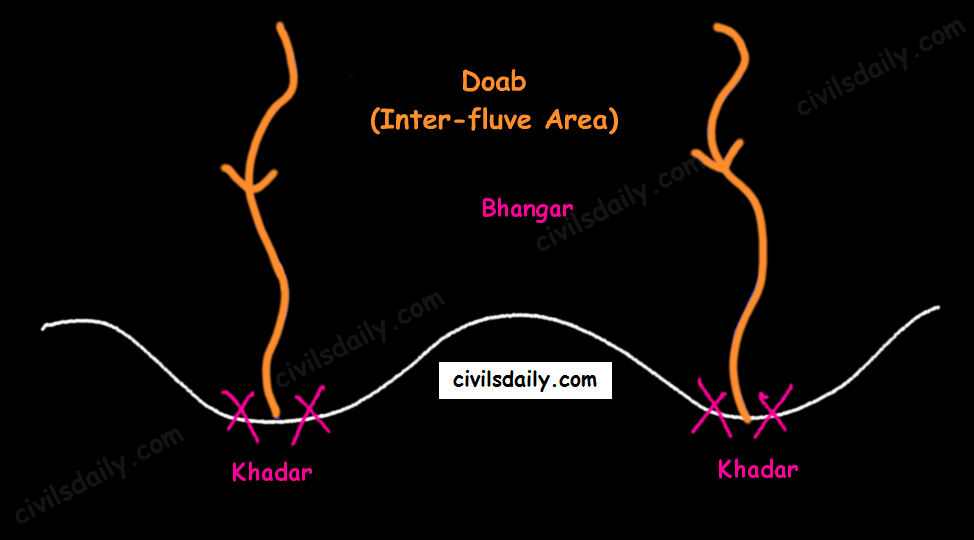
- Khadar: the newer alluvium deposited by floods annually, enriches the soil by depositing fine silts, light colour, found near river beds, porous in nature. Bhangar: older alluvium, clayey, darker, has lime nodules called Kankars, found in doabs (inter-fluve areas).
- Alluvial soils of the northern plains —> transported soils —>, therefore, lack humus —> lack nitrogen [That is why we need to use nitrogenous fertilisers in the northern plains!]. Exception: the Ganga-Brahmaputra delta region is rich in humus.
- These soils lack in nitrogen, phosphorus and humus. However, they are generally rich in potash and lime.
- The soil profile has no stratification.
- Alluvial soils are intensively cultivated.
- In certain areas, these soils are covered with unproductive wind-borne soil called Loess.
- Limitations:
- Allow water to sink into lower strata, and
- Lack nitrogen (But these soils are capable of fixing nitrogen very rapidly through leguminous crops (peas, beans, cloves etc.)
- Suitable Crops: Wheat, rice, maize, sugarcane, pulses, oilseeds, fruits and vegetables, leguminous crops.
2. Black Soil
- These soils are locally known as the ‘Regur Soil’ or the ‘Black Cotton Soil’. Internationally, these are known as ‘tropical chernozems’. These soils are famous for the cultivation of cotton.
- Formation: These have mainly formed from the Deccan Trap rocks —> Zonal Soils
- Areas: These are found in the Deccan trap region. Black soil covers most of the Deccan Plateau which include parts of:
- Maharashtra,
- Madhya Pradesh,
- Gujarat,
- Andhra Pradesh and some parts of
- Tamil Nadu.
- Soil Texture: Black cotton soil (regur soil) is highly argillaceous i.e. clayey. It is deep and impermeable and thus has high water retention capacity.
- Soil Colour: These soils are black in colour due to the presence of iron, aluminium compounds and humus.
- Other Characteristic Features:
- These soils are rich in minerals and known for their fertility.
- The soil depth varies from place to place. It is very thick in lowlands but very thin on highlands. Also, in the upper reaches of the Godavari and the Krishna, and the northwestern part of the Deccan Plateau, the black soil is very deep.
- These soils swell and become sticky when wet and develop deep wide cracks when dry. This helps in self-aeration, which leads to the absorption of nitrogen from the atmosphere. Thus, there occurs a kind of ‘self ploughing’. This aeration and oxidisation to deep levels contribute to the maintenance of the fertility of these soils. This continued fertility is favourable in the area of low rainfall for cotton cultivation even without irrigation.
- Due to slow absorption and loss of moisture, the black soil retains the moisture for a very long time, which helps the crops, especially, the rain-fed ones, to sustain even during the dry season.
- Chemically, the black soils are rich in lime, iron, magnesia and alumina. They also contain potash. But they lack in phosphorous, nitrogen and organic matter.
- Suitable Crops: These soils are highly productive and well suited to the cultivation of cotton, pulses, millets, linseed, tobacco, sugarcane, vegetables and citrus fruits.
Note: In the southern and eastern parts of the country where rainfall is heavy, black soils often occur in close proximity to red soils. Black soils occupy valleys and low-level areas whereas the red soils occur on higher slopes and hilltops. Mixed black and red soils occur in Coimbatore, Madurai, Tirunelveli (Tamil Nadu) and Bundelkhand region.
3. Red and Yellow Soils
- Locally called ‘Chalka’ in Andhra Pradesh.
- Formation: These are derived from granites, gneisses and other metamorphic rocks —> Zonal Soils. These are formed under well-drained conditions.
- Areas: Along the piedmont zone of the Western Ghat, a long stretch of area is occupied by red loamy soil. Yellow and red soils are also found in parts of Orissa and Chattisgarh and in the southern parts of the middle Ganga plain. They encircle the black cotton soil zone.
- Soil Colour: The soil develops a reddish colour due to a wide diffusion of iron in crystalline and metamorphic rocks. It looks yellow when it occurs in a hydrated form. Often, their upper layer is red and the lower layer is yellow.
- Soil Texture: Varies from sand to clay and loam.
- Other Characteristic Features:
- The fine-grained red and yellow soils are normally fertile, whereas coarse-grained soils found in dry upland areas are poor in fertility.
- Have a porous and friable structure.
- They are generally poor in nitrogen, phosphorous and humus.
- These soils are airy and need irrigation for cultivation.
- Intense leaching is a menace in these soil areas.
- Suitable Crops: In places where irrigation facilities are available, the crops cultivated are wheat, cotton, pulses, tobacco, millets, oilseeds, potato, maize, groundnut and orchards.
4. Laterite Soil
- The word laterite has been derived from the Latin word ‘Later’ which means brick. These soils when wet are as soft as butter but become hard and cloddy on drying. Therefore, these are widely cut as bricks for use in house construction.
- Formation: The lateritic soils are particularly found on high flat erosion surfaces in areas of high(>200cm) and seasonal rainfall. The alternating wet and dry seasons lead to the leaching away of the siliceous matter of the rocks leaving behind the compounds of iron and aluminium. These are zonal soils.
- Areas: These soils have mainly developed in the higher areas of the Peninsular plateau. The laterite soils are commonly found in Karnataka, Kerala, Tamil Nadu, Madhya Pradesh and the hilly areas of Orissa and Assam.
- Soil Colour: Reddish-brown in colour due to the presence of iron oxide.
- Other characteristic features:
- With rain, lime and silica are leached away, and soils rich in iron oxide and aluminium compound are left behind(thus the reddish-brown colour). Also, the humus content of the soil is removed fast by bacteria that thrive well in high temperature.
- These soils represent the end product of decomposition and are generally low in fertility.
- The pebbly crust is the important feature of laterites which is formed due to alteration of wet and dry periods.
- These soils are acidic in character due to leaching. Application of manures and fertilisers is required for making these soils fertile for cultivation.
- These soils are poor in organic matter, nitrogen, phosphate and calcium, while iron oxide and potash are in excess.
- Suitable crops: Red laterite soils in Tamil Nadu, Andhra Pradesh and Kerala are more suitable for tree crops like cashew nut. These soils are also suitable for tea plantations.
We discussed in detail alluvial, black, red and laterite soils. Let’s continue the discussion and move on to the next soil types!

5. Arid Soils
- Formation: These are derived from the disintegration of adjacent rocks and are largely blown from coastal regions and Indus valley.
- Areas: Arid soils are characteristically developed in western Rajasthan, which exhibits characteristic arid topography.
- Soil Colour: Arid soils range from red to brown in colour.
- Soil Texture: They are generally sandy to gravelly in texture and have a high percentage of soluble salts.
- Other characteristic features:
- These are saline in nature. In some areas, the salt content is so high that common salt is obtained by evaporating the saline water.
- Due to the dry climate, high temperature and accelerated evaporation, they lack moisture and humus.
- These soils are deficient in nitrogen and humus. The phosphate and iron content is normal. These soils are rich in minerals but the main limitation is the lack of water.
- The soils exhibit poorly developed horizons.
- Plants are widely spaced.
- Chemical weathering is limited.
- Lower horizons of the soil are occupied by ‘kankar’ layers because of the increasing calcium content downwards. The ‘Kankar’ layer formation in the bottom horizons restricts the infiltration of water, and as such when irrigation is made available, the soil moisture is readily available for sustainable plant growth.
- Suitable crops: If irrigated these soils give high agricultural returns. The availability of water from the Indira Gandhi canal has transformed the agricultural landscape of desert soils of western Rajasthan. These soils are mainly devoted to bajra, pulses, guar, fodder and less water requiring crops.
6. Saline and Alkaline Soils
- They are also known as Usara soils. Various local names for saline soils are Reh, Kallar, and Chopan, Rakar, Thur, Karl etc.
- Formation:
- These soils have developed in areas with dry climatic conditions (in areas having a little more rainfall than the areas of desert soils) accompanied by lack of proper drainage. In this situation, salts of sodium, calcium and magnesium are deposited on the upper layer of the soil by capillary action.
- In the Rann of Kuchchh, the Southwest Monsoon brings salt particles and deposits there as a crust.
- These soils are also formed when saline water spreads on the land at the time of high tide in coastal areas. Also, seawater intrusions in the deltas promote the occurrence of saline soils.
- Salinization also occurs because of over-irrigation (canal irrigation/groundwater use) and in areas of the high water table (as in the coastal areas of Maharashtra and Tamil Nadu). Salinity from irrigation can occur over time wherever irrigation occurs. This is because almost all water (even natural rainfall) contains some dissolved salts. When the plants use the water, the salts are left behind in the soil and eventually begin to accumulate. Also, excessive irrigation with dry climatic conditions promotes capillary action, which results in the deposition of salt on the top layer of the soil (See the following figure).
- These are thus, intrazonal soils.
- Areas: They occur in arid and semi-arid regions, and in waterlogged and swampy areas. These are more widespread in western Gujarat, deltas of the eastern coast and in Sunderban areas of West Bengal.
- Soil Texture: Their texture ranges from sandy to loamy.
- Other characteristic features:
- Because of capillary action, the salts are sucked up in solution to the surface and form white encrustations on the surface (See the picture below).
- The salt efflorescence of calcium, magnesium and sodium makes these soils infertile.
- Saline soils contain an excess of neutral soluble salts of chlorides and sulphates whereas sodic or alkali soils contain sodium carbonates/ sodium bicarbonates.
- They lack in nitrogen and calcium and have low water-bearing capacity.
- These soils can be reclaimed by improving drainage, by applying gypsum and/or lime, and by cultivating salt-resistant crops like barseem, dhaincha and other leguminous crops.
- The saline and alkaline soils may occur in any group of soils.
- Because of capillary action, the salts are sucked up in solution to the surface and form white encrustations on the surface (See the picture below).
- Crops grown: In coastal areas, coconut trees are found in plenty in these soils. As discussed above, cultivating salt-resistant crops like bar seem, dhaincha and other leguminous crops can help in reclaiming these soils.
- Note: In the areas of intensive cultivation with excessive use of irrigation, especially in areas of green revolution, the fertile alluvial soils are becoming saline. In such areas, especially in Punjab and Haryana, farmers are advised to add gypsum to solve the problem of salinity in the soil.
7. Peaty Soils
- These soils are locally called Kari in Kottayam and Alleppey districts of Kerala.
- Formation: These are marshy soils and are a result of waterlogging and anaerobic conditions (which leads to partial decomposition of organic matter).
- Areas: They are found in the areas of heavy rainfall and high humidity, where there is a good growth of vegetation. It occurs widely in the northern part of Bihar, the southern part of Uttaranchal and the coastal areas of West Bengal, Orissa and Tamil Nadu.
- Soil Colour and Texture: These soils are normally heavy and black in colour
- Other characteristic features:
- These soils are characterised by a rich humus and organic content.
- There is a presence of iron and varying amounts of organic matter (10-40%). The organic matter in these soils may go even up to 40-50 per cent.
- These soils are generally acidic in nature. But at many places, they are alkaline also.
- Suitable crops: These are generally submerged during the rainy season and utilised for the cultivation of rice.
8. Forest Soils
- Formation: As the name suggests, forest soils are formed in the forest areas where sufficient rainfall is available.
- Areas: These are found in the forest areas of Himalayas, Sahyadris, Eastern Ghats and terai region.
- Soil colour and texture: The soils vary in structure and texture depending on the mountain environment where they are formed. They are loamy and silty on valley sides and coarse-grained in the upper slopes. Their colour is dark brown.
- Other Characteristics:
- In the snow-bound areas of the Himalayas, they are acidic with low humus content. This is because humus is rawer at higher levels. Also, these soils are subjected to denudation due to landslides and snowfall.
- The soils found in the lower valleys are fertile and rich in organic content.
- Owing to sharp differences of hill slopes and climates, these soils may differ greatly even when in proximity. [Recall here the discussion on the impact of topography on soils!]
- Also, these soils exist in thin layers because of their development on the mountain slopes.
- These soils are poor in potash, phosphorus and lime.
- Soil erosion is a major problem in these areas.
- Crops grown: The slopes are used for horticulture and plantations crops like tea, coffee, spices, apple, peach etc. Rice and wheat are grown in valleys. Potatoes are grown in mostly all areas.
Now that we are done with all the soil types, expand the following image for a quick revision!
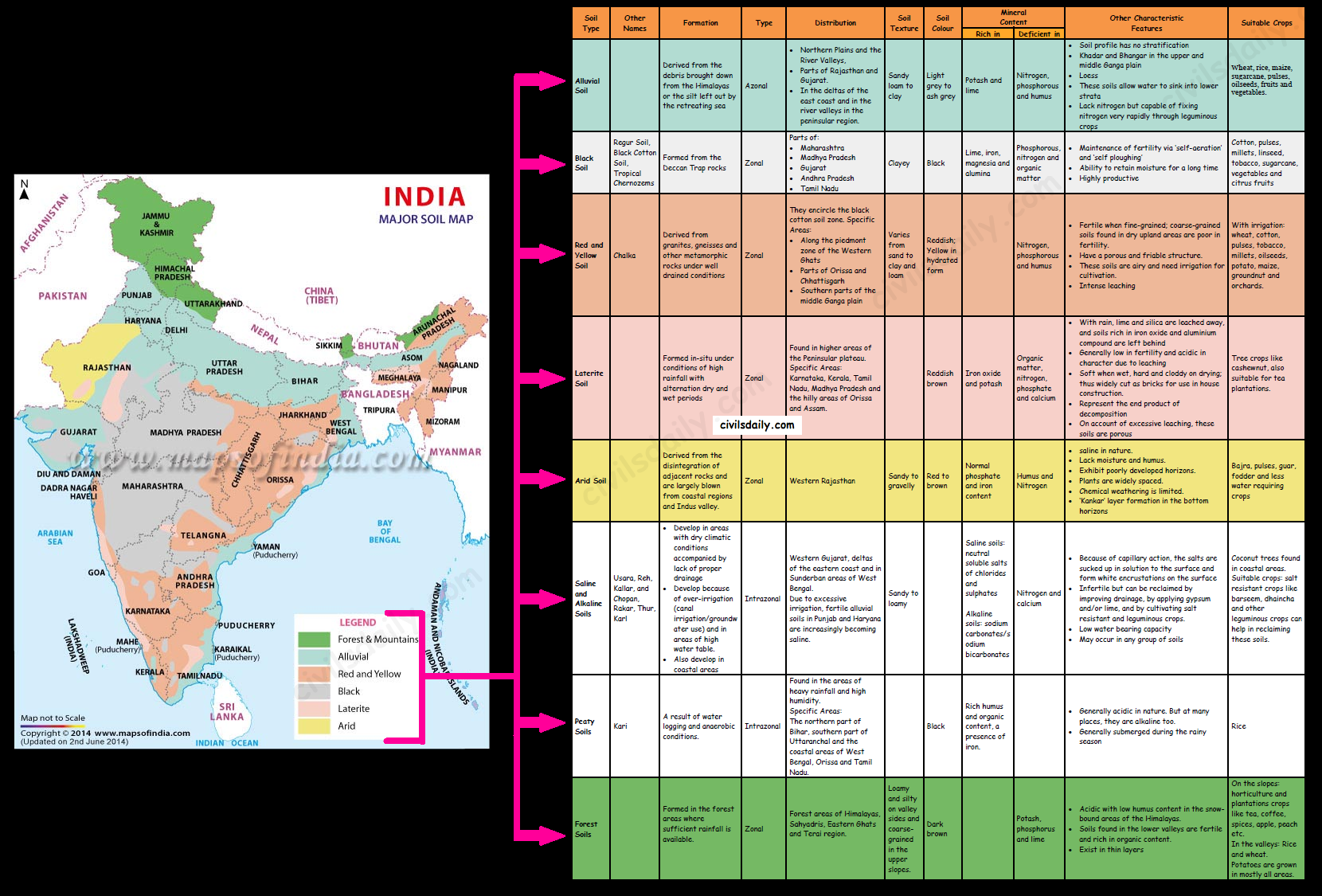
Methods of Irrigation
Irrigation
- Irrigation is the artificial application of water to the soil or agricultural field. It is the replacement or supplementation of rainwater with another source of water. It is used in dry areas and during periods of inadequate rainfall.
- The main idea behind irrigation systems is to assist in the growth of agricultural crops and plants by maintaining with the minimum amount of water required, suppressing weed growth in grain fields, preventing soil consolidation etc.
Well and Tube Well Irrigation
- Wells are mainly found in U.P., Bihar, Tamil Nadu, etc. There are various types of wells – shallow wells, deep wells, tube wells, artesian wells, etc. From the shallow wells water is not always available as the level of water goes down during the dry months. Deep wells are more suitable for the purpose of irrigation as water from them is available throughout the year.
- At places where ground water is available, a tube-well can be installed near the agricultural area. A deep tube well worked by electricity, can irrigate a much larger area (about 400 hectares) than a surface well (half hectares). Tube wells are mostly used in U.P., Haryana, Punjab, Bihar and Gujarat.
- Merits: Well is simplest, cheapest and independent source of irrigation and can be used as and when the necessity arises. Several chemicals such as nitrate, chloride, sulphate, etc. found in well water add to the fertility of soil. More reliable during periods of drought when surface water dries up.
- Demerits: Only limited area can be irrigated. In the event of a drought, the ground water level falls and enough water is not available. Tubewells can draw a lot of groundwater from its neighbouring areas and make the ground dry and unfit for agriculture.
Canal Irrigation
- Canals can be an effective source of irrigation in areas of low level relief, deep fertile soils, perennial source of water and extensive command area. Therefore, the main concentration of canal irrigation is in the northern plain of India, especially the areas comprising Uttar Pradesh, Haryana and Punjab.
- The digging of canals in rocky and uneven areas is difficult and uneconomic. Thus, canals are practically absent from the Peninsular plateau area. However, the coastal and the delta regions in South India do have some canals for irrigation.
- Two types: Inundation canals, which are taken out from the rivers without any regulating system like weirs etc. at their head. Such canals provide irrigation mainly in the rainy season when the river is in flood and there is excess water. Perennial Canals are those which are taken off from perennial rivers by constructing a barrage across the river. Most of the canals in India are perennial.
- Merits: Most of the canals provide perennial irrigation and supply water as and when needed. This saves the crops from drought conditions and helps in increasing the farm production.
- Demerits: Many canals overflow during the rainy season and flood the surrounding areas. Canal irrigation is suitable in plain areas only.
Tank Irrigation
- A tank is developed by constructing a small bund of earth or stones built across a stream. The water impounded by the bund is used for irrigation and other purposes. Tank comprises an important source of irrigation in the Karnataka Plateau, MP, Maharashtra, Odisha, Kerala Bundelkhand area of UP, Rajasthan and Gujarat.
- Merits: Most of the tanks are natural and do not involve heavy cost for their construction and have longer life span. In many tanks, fishing is also carried on, which supplements both the food resources and income of the farmer.
- Demerits: Many tanks dry up during the dry season and fail to provide irrigation when it is required. Lifting of water from tanks and carrying it to the fields is a strenuous and costly exercise.
Drip Irrigation
- In drip irrigation, water is applied near the plant root through emitters or drippers, on or below the soil surface, at a low rate varying from 2-20 liters per hour. The soil moisture is kept at an optimum level with frequent irrigations.
- Among all irrigation methods, drip irrigation is the most efficient and can be practiced for a large variety of crops, especially in vegetables, orchard crops, flowers and plantation crops.
- Merits: Fertilizer and nutrient loss is minimized due to localized application and reduced leaching. Field leveling is not necessary. Recycled non-potable water can be used. Water application efficiency increases. Soil erosion and weed growth is lessened.
- Demerits: Initial cost can be more, can result in clogging, wastage of water, time and harvest, if not installed properly.
Sprinkler Irrigation
- In this method, water is sprayed into the air and allowed to fall on the ground surface somewhat resembling rainfall. The spray is developed by the flow of water under pressure through small orifices or nozzles. The sprinkler irrigation system is a very suitable method for irrigation on uneven lands and on shallow soils.
- Nearly all crops are suitable for sprinkler irrigation systems except crops like paddy, jute, etc. The dry crops, vegetables, flowering crops, orchards, plantation crops like tea, coffee are all suitable and can be irrigated through sprinklers.
- Merits: Suitable to all types of soil except heavy clay. Water saving. Increase in yield. Saves land as no bunds etc. are required.
- Demerits: Higher initial cost. Under high wind conditions and high temperature distribution and application efficiency is poor.
Other Types of Irrigation
- Furrow Irrigation: Furrow irrigation is a type of surface irrigation in which trenches or “furrows” are dug between crop rows in a field. Farmers flow water down the furrows and it seeps vertically and horizontally to refill the soil reservoir. Flow to each furrow is individually controlled.
- One of the difficulties of furrow irrigation is ensuring uniform dispersion of water over a given field. Another difficulty with furrow irrigation is the increased potential for water loss due to runoff.
- Surge Irrigation: Surge irrigation is a variant of furrow irrigation where the water supply is pulsed on and off in planned time periods. The wetting and drying cycles reduce infiltration rates resulting in faster advance rates and higher uniformities than continuous flow.
- Ditch Irrigation: It is a rather traditional method, where ditches are dug out and seedlings are planted in rows. The plantings are watered by placing canals or furrows in between the rows of plants. Siphon tubes are used to move the water from the main ditch to the canals.
- Sub Irrigation or Seepage Irrigation: It is a method of irrigation where water is delivered to the plant root zone from below the soil surface and absorbed upwards. The excess may be collected for reuse.
- Advantages are water and nutrient conservation, and labor-saving.
- The outfitting cost is relatively high. Potential problems, such as the possibility of increased presence of disease in recycle water.
UPSC 2022 countdown has begun! Get your personal guidance plan now! (Click here)
Samanvaya: Free 1-to-1 mentorship for UPSC IAS
Fill up this form to schedule a free on-call discussion with senior mentor from Civilsdaily. Once submitted we will call you within 24 hours.
